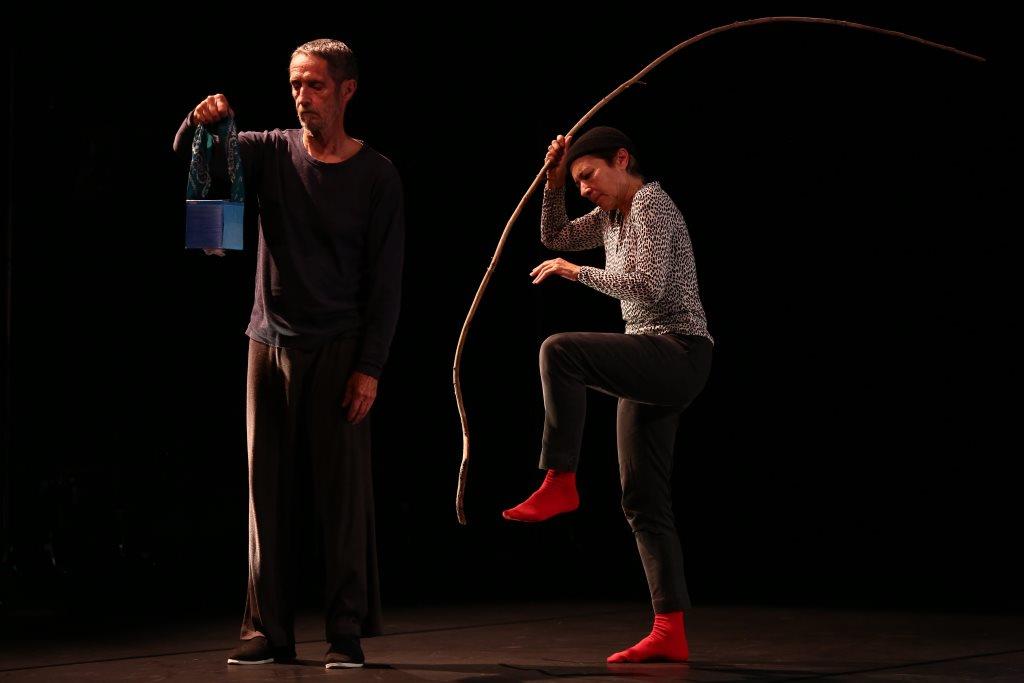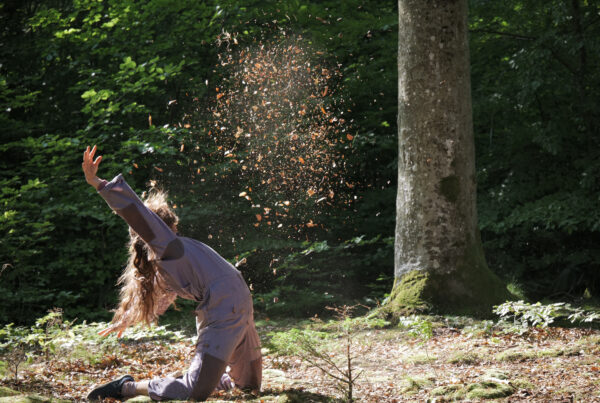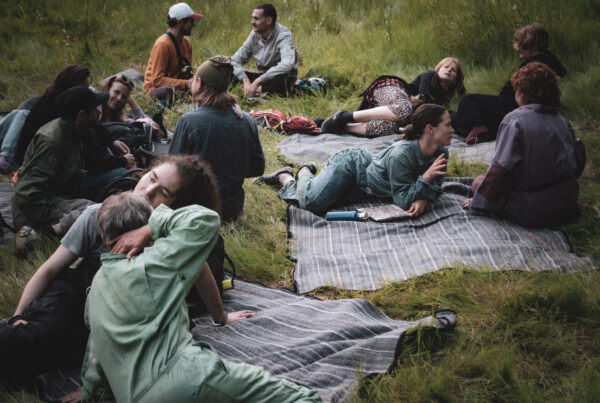BodyCartography Project’s Olive Bieringa and Otto Ramstad interview master improviser, Lisa Nelson, who recently performed with Steve Paxton at the Walker Art Center.
By Olive Bieringa for mn.artists.org
November 24, 2014
One important thing is that I find one dance leads to the next. In my experience, it’s not so much that I make a dance, but that one curiosity leads to the next. For me, the process of making things is totally intertwined with context — it always has been. In fact, what I’m actually making are contexts, I think; I don’t make movement as such. When you’re in process, everything that happens through the day is put into the mixer of your making. That’s the thrill of being in a making process: you have that container, those questions that can be answered all day long. It’s not studio-dependent; it’s not dependent, even, on your collaborators being present all the time.
Through my 20s and mid-30s, I can’t believe how much I churned out – I made one thing after the other, in many different media; I made and performed all the time. Over time, circumstances changed and I found I needed more time, that I didn’t want to have performance dates lined up well into the future. Then, beginning in my late 30s, spontaneously finding performance opportunities when I wasready to present new work somehow eluded me. As a result, presenting work became a less important part of my practice of making— that was a big shift for me.
I also moved from working solo or one-on-one, to making dances as a group process. I wanted to explore what collaboration could look like if everybody was an equal contributor in the construction of something—it’s one of the bases of Tuning Scores. The practice of Tuning with a group, particularly through the ’90s with the group Image Lab, embedded the practice of observation into the practice of action and the scores became performances in themselves, whereas the solo and one-on-one works really required an audience to supply the invisible forces necessary for me to be an instrument of the work, rather than the work being my instrument. With the Tuning Score, a new contextualization arose that I call “Observatories.”
Let’s go back to what you said about “making a context” for a moment. If you’re not creating movement, per se, but rather context – what sort are you making? Are you creating a context for more questions, for research?
When I was making and presenting a lot of work in sequence, the context I set about making could be a choreographic frame – that is, finding a frame to make visible some idea that I was working on. Other such “contexts” might have had to do with what kind of performance opportunity there was for the work, whether it was formal or informal, for example. Those were the two poles of what I mean by making performance context. Lead time was also an important factor, whether I was performing something in the middle of its development or ¾ into its development or closer to the beginning. The frame for performance actually had to be somewhat flexible — I had to define the minimum conditions that I could reconstruct in each performance, that could be repeatable in any space. I would call this a ‘dependable’ score.
You’re using the past tense. Is this way of making contexts that you developed years ago still part of your current practice?
Yes. Though the latest work with Steve [Paxton] is a departure from creating for flexible contexts. We’ve created a completely fixed space to inhabit.
Early on, I rehearsed to develop with somebody a frame and an idea to pursue. Rehearsing was a way to share, at first, what each of us was working on, an opportunity to see what sparked in us some shared interest from which we could start to craft a form. Sometimes, the need to rehearse was just a practical one. I was also making a lot of visual work – video puppetry work – at the time, which was very anal and much more set. Coordinating these things demanded precise practice on stage before the actual performance.
How does teaching, leading workshops and the like, play into your process of making? You’ve done a lot of that.
Teaching was actually where my interest in working with a group came from. I never would have wanted to do so otherwise. But I found I had to construct ways of directing time in my classes, in my teaching. And I always went towards teaching long workshops because I just wasn’t good at conceiving short thoughts. That led fairly naturally to more ensemble-driven work, more collaborative ways of making. So, even though I hadn’t really intended my own practice to go that way, after a while I realized how much that way of teaching had led me somewhere that I could be interested in pursuing further in my dance making.
In the ‘70s and ‘80s, there was only a very small tribe of people teaching what are now called “somatically-based” dance activities. There were so few of us that I felt an obligation to offer a lot of additional, underground work – in the use of the body, for example. I taught composition, so it seemed important to get to what was underneath that; I needed to spend a lot of time with practice connecting with the body in ways there just wasn’t a lot of support for here. That kind of instruction was always new for people, and I always was teaching overseas. Little by little, by the ’90s there began to be a bigger tribe of people bringing these kinds of synthesized ways of working – somatic training integrated into improvisational training, into technical training and such. Young people began coming to my workshops with more nuanced understandings about the use of the body and the individual empowerment of the dancer and the person. But that kind of synthesized dance instruction isn’t consistent; it’s not constant. I still don’t feel like I can just skip it in my workshops. We’re not at the point where we can assume this next generation of dancers has had training that focuses on somatic knowledge. I mean, it’s better now, but many young dancers are still starting from scratchola with regard to how to work with and within the body.

Photo: Paula Court
Can we come back to your dance making? What happens for you when you’re making a dance as a soloist now? Is this a 20-minute dance? Is it a half-hour dance? Is it a 10-minute dance? Could you explain the frame, and then could you explain the working time before, the working time inside, and then the working time afterwards? What is that?
I can only give one example, because I just recently started doing solos again. I have a full evening of performance to do, so I’m gonna do different events in that time. I’ve been revisiting a dance I made in 1982, called Dodo, which I made as a kind of encapsulation of things I had been researching about vision for the 10 years prior. That work is a score for the relationship between my breathing and my visual activity, or the activity of my eyes. (The eyes are not only visual.) I performed Dodo for about six years. Then, in 1991, I used the basis of that score, and added a new challenge, which manifested as [a consideration of] two sticks and two sides of my brain.
But you thought about adding to it once more?
I had a very short period of time to develop the performance – just a few months. I was invited to perform that piece after someone saw a 1985 version of it on video. I said, OK, That’s interesting. I think I’ll try that on. When I revisited the old score, it was so interesting to me, because my body now is so different. My abilities are so diminished from what they were then, too – miniaturized physically, but also massively more sophisticated, internally. I found it an interesting challenge. In one of the performances, after the solo, I invited some colleagues to do a series of blind unison trios.
I’ve used blind trios in performance in various ways over the years – I find them fascinating to do– but, mostly, I never tire of watching them. It was very informative, for me as well as the audience, to see the trios in proximity to the solo, to see both those works as a choreographic continuum.
I come to a venue prepared with a piece, but I don’t really know how to frame something well until I’m right there in the space where it’s going to happen. I’m so aware of the looking experience that I’m always making a bunch of decisions based on the venue and the context: whether people have been waiting for a while, or have just arrived, if there is sound leaking in from outside the space, how the sight-lines are, etc. All of that matters, and improvising based on those circumstances is very much part of the finished material.
And what about the piece you’re doing now with Steve Paxton, Night Stand — you’ve performed that how many times?
It’s been almost 10 years since we made it. We performed it in, maybe, six venues over its first six years. Not so much. And then took a three-year break in that time until we performed it again last year.
And PA RT, the duet you made before that—
We made that in 1978 and performed it occasionally but continually for 24 years.— at least at one venue a year, sometimes more, and in very different contexts.
And the frame for those two pieces — what differentiates them? What defines the dance? Is it the soundtrack? The scoring?
They’re totally different works. PA RT was very open-scored, but it had a fixed sound track—an opera by the composer Robert Ashley called Private Parts— that provided an unvarying environment; the costumes were always the same; as was the structure of solo/duet/solo/duet. Each of our inner movement scores and our interaction with each other (or not) were totally open. The work itself was quite open, though it made its own history over time.
And fixed props, too, no?
No, we didn’t have props in PA RT. It was just dancing, and the lights were different depending on the venue. The first, maybe 15 years of performing it, we didn’t do much with the lights. And then we tried a very simple shaping for the last number of years, when we found ourselves more often on stages. We performed in the widest range of settings imaginable, formal to most informal. It was an infinitely malleable dance.
The new piece, that we made in 2004 with lighting designer Carol Mullins, Night Stand, is vastly different in that we made a non-variable spatial setting to inhabit. And built props with which we can constantly reshape the space.
The soundtrack and lighting design, and set pieces were all built for this dance, built for a specific sized space, and they provide a setting for the dance to happen in. The music is constructed from a number of musical pieces and kinds of sound and a lot of silence. For Night Stand, Steve and I have a shared focus which is more concentrated on the space and the time than on the dancing per se. This dance is unrehearsable outside of the theater, and the first version we made in 2004 felt unfinished. Last year, we finally had an opportunity at DIA:Chelsea in NY to work on it for a couple of weeks and we felt like we finally finished constructing it.
That’s interesting. How do you know that it’s done?
We knew. It made sense to us, so that we could live inside it.
Doing it again at the Walker Art Center, we’re not going to have the prep time we had the last time, sadly. Because this dance needs a very deep big space with an intimate house, it’s hard to find venues. At the Walker, we’re only going to let nine rows in. We want to keep it close.
Is there anything else you’d like to add, that we haven’t covered, to address the question from the beginning: How do you make a dance?
Besides the idea of making as a “habit “– that is, you’re constantly making — my feeling is that the dances make me. The very idea of making a dance kind of freezes me up; then, I have to think about what to make.
What’s important to share? I always have needed to have a good reason to show something, and so, for me, that question was part of the context building I did for myself: Why do I want to show this work? That was so important, I would choose not to show something if I couldn’t really feel the necessity of doing so. For example, I rarely perform where I live in Vermont. I just don’t see what it would offer the life here. It’s wonderful that people perform, I’m glad they do. But I never felt my work was entertaining, so I somehow needed to understand the context of the work in order to frame it. My conversation is much more concerned with how to live, how to be in the world as an imagined and constructed being. To be frank, I’m not looking so much for affirmation in performance: I don’t need to hear that I did a good job or that the work is beautiful. I’m actually a very shy person, and even from childhood, it’s made me uncomfortable to receive compliments. Even so, I like to tell people that I see things. But I want to engage in a different kind of conversation with audiences after I manifest something. My best audiences are people who are asking the same questions I am – about what it is to be embodied. What it is to live in a body and go through this short lifetime? What’s the potential of our imagination in so living? I mean, it’s not really the potential of our bodies that matter, but of our imaginations.
I like that. That’s my question. And what I haven’t achieved with that, as a performer, is enormous. Maybe if I had stayed in the grind of incessant making, maybe if I’d stayed in the passion of that, I would’ve passed through that question and onto another. But here we are, and that means I get to talk to you guys, which has been, for me, just a joy.
Related links and further reading:
Lisa Nelson performed as part of Composing Forward: The Art of Steve Paxton, at the Walker Art Center November 13 through 22.
“Before Your Eyes: Seeds of a Dance Practice,” by Lisa Nelson (2003, Contact Quarterly dance journal)
“Islands of Imagination: Steve Paxton and Lisa Nelson,” by Blake Nellis for Walker Art Center
“Talking Dance – with Steve Paxton” (video)
“A History of Contact Improvisation in the Twin Cities” (video)
Lisa Nelson was born in New York City in 1949. She began her training in traditional modern dance and ballet as a child at the Juilliard School in New York City and then Bennington College in Vermont. Throughout the 1970s she investigated diverse approaches to dance improvisation, including performing with Daniel Nagrin’s Workgroup in 1971-72, and began her research into vision and the performance of movement through the medium of video. Her intensive practice in dance and video led her to develop the Tuning Scores, a rigorous model for real-time editing and communication for ensemble and solo work. Nelson performs, teaches, and creates dances internationally, and maintains long-term collaborations with other artists, including Image Lab, Daniel Lepkoff, Steve Paxton, Scott Smith, and Cathy Weis.
Nelson received a New York Dance and Performance Award, or Bessie, in 1987, and an Alpert Award in the Arts in 2002. She has co-edited Contact Quarterly, a journal focused on dance and improvisation since 1977, and directs Videoda, a project that archives, produces, and distributes videotapes of improvisational dance. In 2001, the French-language magazine Nouvelles de Danse published an issue about her work, titled Vu du Corps: Lisa Nelson, Mouvement et Perception. She lives in Vermont.
Interviewers: As co-directors of the BodyCartography Project, Olive Bieringa and Otto Ramstadinvestigate empathy and the physicality of space in urban, domestic, wild and social landscapes through dance, performance, video, installation work and movement education. Our works range from intimate solos for the street or stage, to large site based community dance works, short experimental films in the wilderness, to complex works for the stage. We have created numerous performance works, short films and installations across the USA, Canada, New Zealand, Japan, Europe, Russia and South America and were recently named Dance Company of the Year by the City Pages. Recent works include Super Nature, with composer Zeena Parkins, commissioned by the Walker Art Center, Performance Space 122 and PADL West. Symptom, with Minnesota twins Emmett and Otto Ramstad and Mammal, a commission for the Lyon Opera Ballet. Our trilogy Holiday House (2005-2007) was commissioned in part by the Walker Art Center, Minneapolis and was the winner of two Minnesota Sage Awards. Our site spectacle Lagoon was the winner of the Perlorous Trust Creativity Award at the New Zealand Fringe Festival in 2003. We are featured artists in the first book about site dance in the USA published by University of Florida Press entitled, Site Dance: The Lure of Alternative Spaces.
Photo: Steve Paxton and Lisa Nelson in Night Stand. Photo: Paula Court



